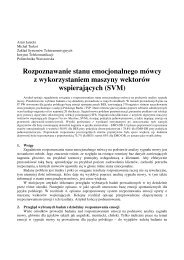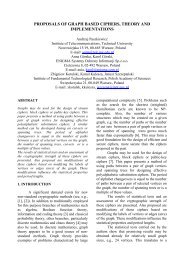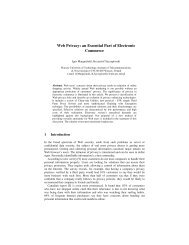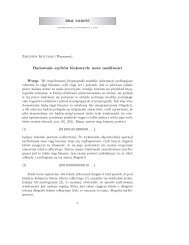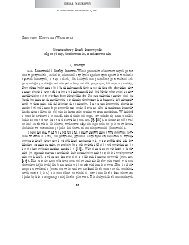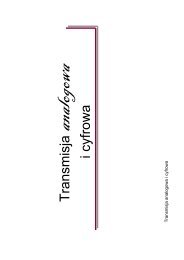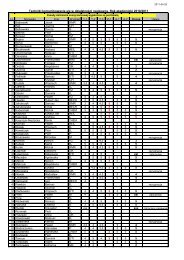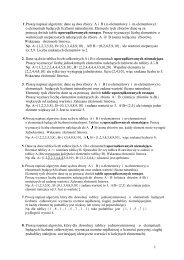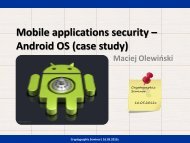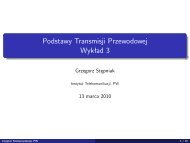supporting different classes of service in ethernet switches with ...
supporting different classes of service in ethernet switches with ...
supporting different classes of service in ethernet switches with ...
Create successful ePaper yourself
Turn your PDF publications into a flip-book with our unique Google optimized e-Paper software.
Border Router (BR) are configurable. S<strong>in</strong>ce we want to perform the tests <strong>in</strong> conditions when ES is a<br />
bottleneck we set the capacities C 1 and C 2 equal. To create the congestion conditions <strong>with</strong> a<br />
m<strong>in</strong>imum set <strong>of</strong> term<strong>in</strong>als generat<strong>in</strong>g traffic (which is important when perform<strong>in</strong>g trials <strong>in</strong> test bed)<br />
the <strong>in</strong>put l<strong>in</strong>ks are configured <strong>with</strong> capacity 100Mbps i.e. 10 times faster than l<strong>in</strong>ks C 1 and C 2 .<br />
We have evaluated the possibility <strong>of</strong> <strong>support<strong>in</strong>g</strong> e2e CoSs <strong>in</strong> a set <strong>of</strong> scenarios, where the<br />
traffic from only one e2e QoS CoS (Telephony, RT-Interactive, etc.) together <strong>with</strong> STD CoS traffic<br />
was present at the same time. In each test we measured relevant QoS parameters <strong>of</strong> a s<strong>in</strong>gle traffic<br />
stream constitut<strong>in</strong>g so called Foreground Traffic (FT). However, for these measurements to be<br />
adequate we provoked the worst traffic conditions <strong>in</strong> the network that are allowed by CAC<br />
algorithm. It means that we loaded a tested e2e CoS to ρmax value. This additional type <strong>of</strong> traffic<br />
creat<strong>in</strong>g CAC limit condition, we refer to as Background Traffic (BT). The FT and BT were<br />
appropriately modelled depend<strong>in</strong>g on the type <strong>of</strong> tested e2e QoS CoS. Due to space limitation <strong>in</strong> this<br />
paper we present only the simulation results obta<strong>in</strong>ed for the case <strong>of</strong> Telephony and STD CoS.<br />
In the performed tests we <strong>different</strong>iated between the case where the STD CoS traffic used<br />
TCP (section 4.1) or UDP (section 4.2). This <strong>different</strong>iation is important because the applied<br />
transport protocol impacts traffic characteristics mostly due to the presence or lack <strong>of</strong> closed-loop<br />
congestion control, respectively.<br />
The details <strong>of</strong> simulated traffic scenario are as follows. There are only two types <strong>of</strong> traffic: one<br />
represent<strong>in</strong>g traffic from Telephony CoS, for which we must guarantee target QoS level and the<br />
other one, which represents traffic from STD CoS. The Telephony CoS FT and BT traffic comes<br />
from the term<strong>in</strong>al connected to Ethernet port #2 and STD CoS traffic from term<strong>in</strong>al connected to<br />
port #1. The whole traffic is dest<strong>in</strong>ed to BR across ES and ER. The propagation delay T prop between<br />
ER and BR is set to 0 ms reflect<strong>in</strong>g the low distances between particular elements <strong>of</strong> the Ethernet<br />
access network. The capacity dedicated to Telephony CoS on C 1 l<strong>in</strong>k is C 28-6 =2Mbps. Packets<br />
belong<strong>in</strong>g to this class are 200B long and packets belong<strong>in</strong>g to STD CoS are 1500B long. FT and<br />
BT <strong>of</strong> Telephony CoS are modelled as CBR stream (parameters relevant for G.711 codec) and<br />
Poisson stream, respectively. The parameters <strong>of</strong> the WRED mechanism are the follow<strong>in</strong>g: threshold<br />
is set to 85 pkts (and this value <strong>in</strong>dicates maximum buffer space assumed for STD CoS), dropp<strong>in</strong>g<br />
probability is set to 0.92. The Ethernet shared buffer value is B e =1000 pkts.<br />
The simulation studies were performed us<strong>in</strong>g ns-2 platform [14]. The results were obta<strong>in</strong>ed by<br />
repeat<strong>in</strong>g the simulation tests 12 times and calculat<strong>in</strong>g the mean values <strong>with</strong> the correspond<strong>in</strong>g 95%<br />
confidence <strong>in</strong>tervals. However, the confidence <strong>in</strong>tervals were not given <strong>in</strong> cases they are negligible.<br />
Each simulation test lasted for 1000 seconds.<br />
4.1 TCP STREAMS INTO STD COS<br />
In this test the STD CoS traffic consists <strong>of</strong> N=10 TCP greedy connections. The nom<strong>in</strong>al values<br />
<strong>of</strong> QoS parameters that we assumed for the Telephony CoS <strong>in</strong> Ethernet access network are<br />
summarized <strong>in</strong> table 2 (we refer to them as to “designed values”). These values were used to<br />
determ<strong>in</strong>e the traffic load that we admitted <strong>in</strong>to Telephony CoS.<br />
For this test, the measured IPLR, mean IPTD and IPDV are below target designed values (see<br />
table 2). Measured IPLR equals 0 s<strong>in</strong>ce the buffer space dedicated to Telephony CoS (B 28-6 =10<br />
packets) was much less than the whole Ethernet switch buffer size and the buffer occupancy due to<br />
STD CoS was well controlled. In fact when STD CoS traffic is TCP controlled the maximum STD<br />
CoS queue size Q max (determ<strong>in</strong>ed <strong>with</strong> probability 10 -3 ) deviates only a little from the WRED<br />
threshold which was set to 85 packets (see table 3). Thanks to TCP mechanism, after the STD CoS<br />
queue reaches WRED threshold and the new arriv<strong>in</strong>g packet is dropped, the TCP source slows down




